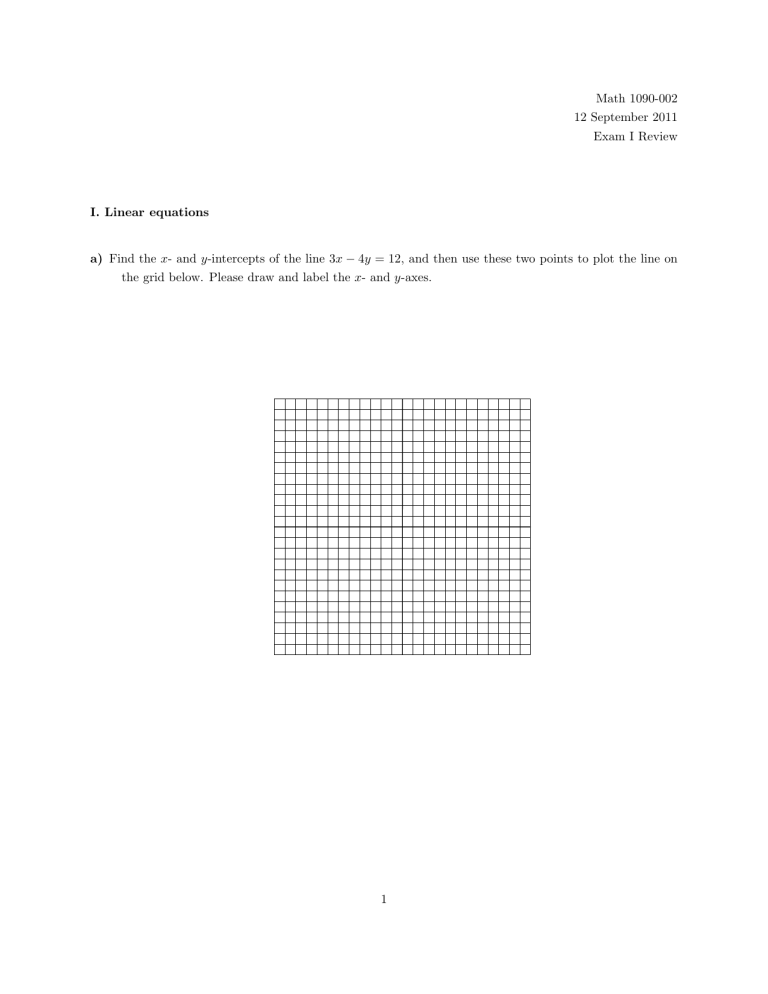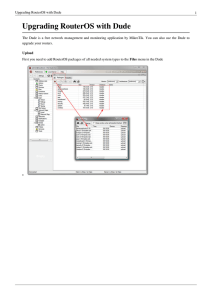Math 1090-002 12 September 2011 Exam I Review I. Linear equations

Math 1090-002
12 September 2011
Exam I Review
I. Linear equations a) Find the x - and y -intercepts of the line 3 x − 4 y = 12, and then use these two points to plot the line on the grid below. Please draw and label the x - and y -axes.
1
b) Find the slope of the line through the points ( − 3 , 0) and ( − 3 , 10).
c) Write down the equation of the line which is parallel to the line
1
2 y − 1 = x and passes through the point
( − 5 , − 1).
d) Write down the equation of the line through the points ( − 5 , 2) and (3 , − 2).
2
II. Linear inequalities a) Solve the following linear inequality and graph the solution on a real number line:
5
3
(2 w + 4) < 25 + 5 w.
Translate the following statements to inequalities, and then solve: b) Three more than twice a number is at least seventeen.
c) Four less than ten times a number is no more than five hundred.
3
Solve the following systems of equations using either the substitution or elimination method.
d)
2 x + 5 y = 7 x − 3 y = − 2 e)
4 x − y = − 1
5 x + y = 19
4
f ) Graph the following system of inequalities on the axes below, and indicate the solution set, i.e. the region in the plane where both inequalities are satisfied.
x ≤ y − 3
4 y < 4( x − 1) .
5
III. Functions
Evaluate each function at the given input values: a) h ( x ) =
10 − x
2 x i) at x = 5 ii) at x =
√ r b) f ( x ) = 1 + x + x 2 i) at x = − 1
2 ii) at x = 1 − t
6
IV. Linear business applications a) Van’s Furniture Store sells a popular rocking chair. They’ve discovered, through market analysis, that the demand for their chair can be modeled by the linear equation 2 p + q = 740, and supply by the equation 2 q = p + 530. Based on this model, what price should they charge for a rocking chair? How many chairs should they expect to sell at this price?
b) A certain commodity has fixed costs of $1800 and variable costs of $35 per unit. If the commodity is sold for $60 per unit, how many units need to be sold in order to break even?
7
V. Graphical linear programming
Some dude is looking to put money into two different investments, call them Investment A and Investment
B. Investment A produces on average a profit of 5 cents for every dollar invested, and Investment B generates a 10% profit. He has a total of $100 , 000 to invest. If he wants to invest any money in B, he must put at least $10 , 000 into A, and the maximum amount invested in B can be no more than three times that invested in A. How can this dude maximize his returns?
a) Define A to be the amount invested in Investment A, and B the amount invested in Investment B. Write down the inequalities that give the constraints for the above scenario, and plot them on the axes below, clearly indicating the “feasible region”, or the set of all possible values of ( A, B ).
8
b) What is the objective function, which describes the quantity we are trying the optimize?
c) Answer the question that is posed in the problem: How can this dude maximize his returns?
9



